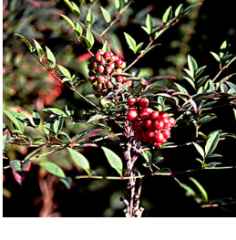
Winter Color In Many Forms |

Winter Color In Many Forms |
Nandina domestica is a plant which offers many varieties to fit many applications. The primary attributes of this group of plants is that they offer winter color and interest. Winter is often a tough void to fill because we tend to focus extensively on spring color without regard to the off season. Since we still come in and out of the house year round, we need not suffer a visually barren season. We can't change the temperature, but we can change the scenery.
Nandinas are evergreens to semi evergreens which come in many sizes and shapes. Desired culture is full sun to part shade. This plant prefers moist, rich garden soil but is not picky about its soil. These conditions make Nandina very adaptable to a variety of situations. They will handle anything but wringing wet conditions. The problems of disease and insects is practically non-existent with this plant. Pruning can be done just about anytime and in any manner. You can be flatly reckless with this plant!
The regular Nandina domestica is tall and upright. In good soil it can become massive, but generally grows 6 feet tall and 4 feet in diameter. The plant is called "Heavenly Bamboo" because it multiplies by shoots emerging form the base. The best pruning method is to cut out older, less productive canes allowing younger, more vigorous canes to come forth. Unlike it's dwarf cultivars, Nandina domestica produces profuse bunches of shiny red berries which make attractive and nutritious food for the birds. The berries are prevalent from November to February. In a hard winter, this plant will suddenly drop every leaf in February, only to refoliate in the spring. This plant looks its worst in the summer and stands out nicely in the winter. This makes Nandina domestica a great foundation plant to fill large corners, provide a back ground, etc. Front and center is a poor placement due to sparseness in the late spring and summer.
Other uprightNandina varieties "Alba" (white fruited) and "Yellow Fruited". We occasionally have "Alba" and I've not seen "Yellow Fruited" though it exists. Possibly yellow is not common because it might look like the red fruited variety prior to ripening. Just a guess.
The dwarf or "mounding " varieties of Nandina tend to be more evergreen in nature. The foliage is more attractive the year round though winter is still their finest hour. These plants produce few or no berries for the wildlife, but they are certainly as easy to grow. They make wonderful borders and provide color where red is desired. The leaves go through a series of color changes including red, pink, gold, lime green, and dark green.
Two of the best varieties are "Fire Power" and "Harbour Dwarf". "Fire Power" is an improvement over "Nandina atropurpurea nana" which occasionally experienced some disease problems. "Fire Power" has broad and colorful leaves, a dome shaped mounding habit generally to a height of 18 inches. The "Harbour Dwarf" is a little more columnar reaching heights of 2 to 3 feet. It's leaves are more narrow and pointed, giving the plant a true miniature appearance of its parent Nandina domestica.
I believe this is a low maintenance plant worthy of consideration. I'll close with a true story about Nandina. We have three hugh standard Nandinas in front of the store. A friend of mine was a jailer who would perennially come and ask to cut gallon sized clusters of shiny red berries for the annual Christmas dinner. We always gladly accommodated her. One year, a different lady came and asked permission to take some berries for the Jail's Christmas dinner. I said, "That's really nice that you guys make this dinner every year." She looked at me in a perplexed manner and then began to laugh. "You think we're doing this for the prisoners! I'm on the jail board." I guess I'm not the sharpest tool in the shed...
Andy Lynn